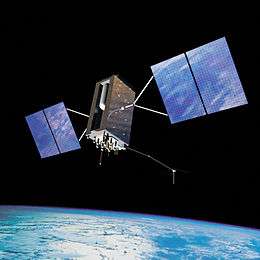USA-289
USA-289, also known as GPS-III SV01 or Vespucci, is an American navigation satellite which forms part of the Global Positioning System. It was the first GPS Block III satellite to be launched.[2]
 Artist's rendering of GPS-III SV01 | |
| Mission type | Navigation |
|---|---|
| Operator | US Air Force |
| COSPAR ID | 2018-109A[1] |
| SATCAT no. | 40730[1] |
| Mission duration | 12 years (planned) |
| Spacecraft properties | |
| Spacecraft | GPS-III SV01 |
| Spacecraft type | GPS Block III |
| Manufacturer | Lockheed Martin |
| Launch mass | 4,400 kilograms (9,700 lb) |
| Start of mission | |
| Launch date | 23 December 2018 UTC |
| Rocket | Falcon 9 |
| Launch site | SLC-40 |
| Contractor | SpaceX |
| Orbital parameters | |
| Reference system | Geocentric |
| Regime | Medium Earth (Semi-synchronous) |
| Perigee altitude | 20,118 km (12,501 mi) |
| Apogee altitude | 20,196 km (12,549 mi) |
| Inclination | 55.00 degrees |
| Period | 716.7 minutes |
| Epoch | 23 December 2018 |
Launch
Built by Lockheed Martin and launched by SpaceX, SV01 was launched on December 23, 2018 atop expendable Falcon 9 booster B1054. The launch took place from Space Launch Complex 40, placing SV01 directly into semi-synchronous orbit.
.jpg)
GPS-III SV01 is launched on a Falcon 9
gollark: You simulate every particle in the FPGA using the universe's physical laws for every test case. Or just run test cases normally.
gollark: The computers are implemented on FPGAs and the security is mathematically proven.
gollark: You have to use their computers for it.
gollark: You have to go to a dedicated physical location to play and are monitored constantly by 3 people.
gollark: Yes there is.
References
- "Navstar 77". US National Space Science Data Center. Retrieved 15 Dec 2019.
- "GPS III Space Vehicle No. 1 "Vespucci" Arrives in Florida, Prepares fo". Los Angeles Air Force Base. Retrieved 2019-12-19.
This article is issued from Wikipedia. The text is licensed under Creative Commons - Attribution - Sharealike. Additional terms may apply for the media files.